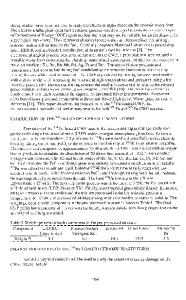Radiation stability of gadolinium zirconate: A waste form for plutonium disposition
- PDF / 223,775 Bytes
- 4 Pages / 612 x 792 pts (letter) Page_size
- 57 Downloads / 261 Views
MATERIALS RESEARCH
Welcome
Comments
Help
Radiation stability of gadolinium zirconate: A waste form for plutonium disposition S.X. Wang Department of Nuclear Engineering and Radiological Sciences, University of Michigan, Ann Arbor, Michigan 48109
B.D. Begg Pacific Northwest National Laboratory, Richland, Washington 99352
L.M. Wang Department of Nuclear Engineering and Radiological Sciences, University of Michigan, Ann Arbor, Michigan 48109
R.C. Ewing Department of Nuclear Engineering and Radiological Sciences and Materials Science and Engineering, University of Michigan, Ann Arbor, Michigan 48109
W.J. Weber Pacific Northwest National Laboratory, Richland, Washington 99352
K.V. Govidan Kutty Materials Chemistry Division, Indira Gandhi Centre for Atomic Research, Kalpakkam 60312, India (Received 12 July 1999; accepted 17 September 1999)
Zirconate and titanate pyrochlores were subjected to 1 MeV of Kr+ irradiation. Pyrochlores in the Gd2(ZrxTi1−x)2O7 system (x ⳱ 0, 0.25, 0.5, 0.75, 1) showed a systematic change in the susceptibility to radiation-induced amorphization with increasing Zr content. Gd2Ti2O7 amorphized at relatively low dose (0.2 displacement per atom at room temperature), and the critical temperature for amorphization was 1100 K. With increasing zirconium content, the pyrochlores became increasingly radiation resistant, as demonstrated by the increasing dose and decreasing critical temperature for amorphization. Pyrochlores highly-enriched in Zr (Gd2Zr2O7, Gd2Zr1.8Mg0.2O6.8, Gd1.9Sr0.1Zr1.9Mg0.1O6.85, and Gd1.9Sr0.1Zr1.8Mg0.2O6.75) could not be amorphized, even at temperature as low as 25 K. Plutonium generated by the nuclear fuel cycle remains one of the daunting environmental challenges of this century.1,2 Plutonium is not only a long-lived environmental contaminant (239Pu half-life ⳱ 24,100 years), but it is fissile (bare critical mass is 15 kg of metal), and plutonium decays to longer-lived, fissile 235U (half-life ⳱ 700 million years). Efforts in the United States and Russia are focused on disposing of approximately 100 metric tons of 239Pu resulting from the dismantling of nuclear weapons, but this is a small fraction of the total global inventory of >1300 metric tons.3 Annual production of plutonium, mainly in reactors for commercial power production, is approximately 70 metric tons. Within a few years it is estimated that the amount of plutonium separated by reprocessing of commercial fuel will exceed military inventories.4 A number of disposition strategies are being pursued, notably “burning” the plutonium as a mixed-oxide fuel5,6 or in an inert matrix;4 however, some plutonium will require immobilization in a solid form for geologic disposal, as will other actinides such as Np and Am. A number of glass compositions7 and crystalline ceramics,8,9 most prominently titanate phase assem4470
http://journals.cambridge.org
J. Mater. Res., Vol. 14, No. 12, Dec 1999 Downloaded: 07 Jun 2014
blages in which zirconolite and pyrochlore are the actinide host phases, 10–12 are under development. A
Data Loading...











